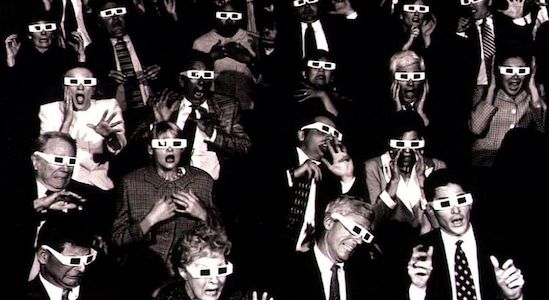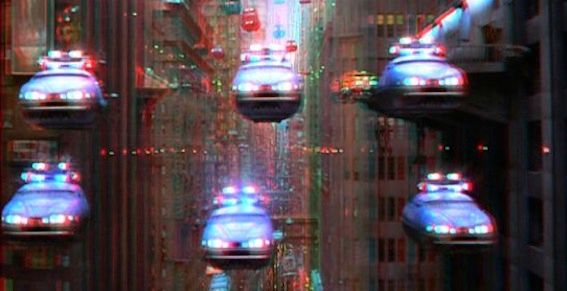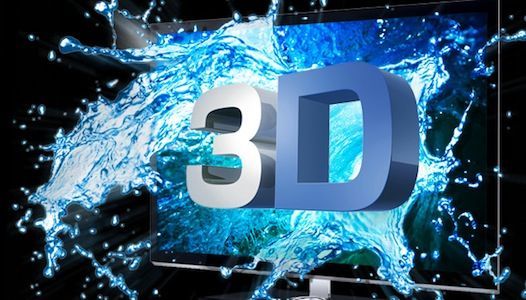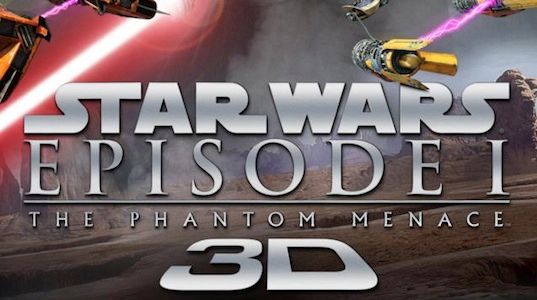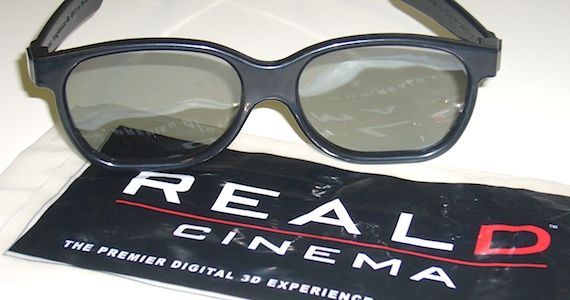Are you one of the many moviegoers concerned with the meteoric rise in 3D productions? It's a trend that many feel will die soon, but some still believe it is only getting warmed up. Either way, it's tough to think of contemporary cinema without the onslaught of 3D movies. We recently talked to one of the talented individuals who painstakingly turns 2D imagery into the 3D experience studios love to provide ($$$).
We wanted to find out more about the 3D conversion process and what the people behind the computers have to say about the technology. Famous filmmakers have been getting these questions nonstop, especially since many of them are giving 3D a try. Steven Spielberg and Peter Jackson answered such questions at San Diego Comic-Con. Martin Scorsese is soon delivering his own 3D adventure movie with Hugo. James Cameron continues to explore the unknown with his technological discoveries in 3D.
Say what you will about 3D, but Hollywood is doing everything it can to make sure the technology sticks around. In addition, an increasing number of sporting events have been shot in 3D. Until something new and exciting comes around, this is what we have to deal with - like it or not. The solution might not be to extinguish the 3D revolution, but to continue researching ways to enhance the experience, like glassless 3D or better, smarter productions.
It also never hurts to better understand what goes into these releases and who the people working on them are. You may be surprised at how much the technicians behind the scenes do to make 3D as immersive as possible.
Adam Hlavac is currently a stereoscopic depth artist working for Stereo D in Burbank, CA. Previously, he held the same position at Legend3D in San Diego, CA, working on such films as Shrek, The Green Hornet, Transformers: Dark of the Moon and most recently on the 3D conversion of Top Gun. As a stereo artist, Hlavac takes the native 2D footage that is captured on set and creates a stereo pair, or "both eyes" of a 3D image. This is done through various techniques along with the help of some high-end compositing and proprietary software. Every post-production studio has their own pipeline for how they go about doing conversion, but in the end it's about creating 3D that is pleasant to watch and doesn't distract you from the point of interest. Hlavac also recently produced his first feature film called Delta Zulu, which is currently in post-production and will be hitting the film festival circuit soon.
SR: What are some classic films you think would be great if re-released in 3D?
Hlavac: Some movies that I personally would like to see done in 3D are: The Fifth Element, Star Trek, The Terminator and T2, The Matrix Trilogy, The Lord of the Rings, Alien and Predator. You notice all of these films fall into the Sci-Fi/Fantasy category.
How did you get started with 3D conversion?
I have always been interested in expanding my knowledge in visual effects and learning about new technologies. As a filmmaker, it's always helpful to be well-versed in every aspect of the art. I saw an opportunity to join a new post-production house that had just completed about twenty minutes of conversion work on Tim Burton's Alice in Wonderland and was starting on the conversion of Dreamwork's Shrek films. It was a one-of-a-kind opportunity for me, since the company was so conveniently located just fifteen minutes from where I live. I had to undergo an interview session, which was primarily to see if I had the ability to see 3D and how well I understood 3D space, modeling, etc. I have been an avid After Effects user for about ten years; combined with general research I've done on 3D modeling, it really helped me understand the concept of 3D conversion. Long story short, I more or less just walked in looking for a job and walked out a stereo depth artist.
The process itself was much easier than I thought. Over the course of a little over a year, I've learned so much about 3D, film, compositing and visual effects. I've gained a whole new appreciation for filmmakers who tackle and successfully execute a 3D film. It's very hard and tedious work. I've gone from a stereo depth artist to a stereo compositor and I'm learning new techniques every day to help expedite the conversion process quicker, but to maintain a top notch quality.
Please explain the process of post-production 3D.
The process of post-production 3D requires us to take the original 2D image and utilizing propriety software we recreate the scene in 3D space, which allows us to add the proper depth and volume to characters and their surroundings. Through conversion we have complete control over what plays out of screen, at screen and in the screen. Once the stereo images have been created, using other production tools and tricks we then put the footage through an artifact removal stage which is basically a final polish to finesse the images. For more details, visit Legend 3D.
Why is 3D so much more effective when it creates depth as opposed to when it brings things out of the screen?
Depth really makes the whole film come to life and it's another way for an audience member to feel like they are in the movie. I think when 3D films just throw things out into the audience's faces, it doesn't really show the full potential of what 3D is supposed to be. 3D should be an enhancement, not a gimmick. In Transformers: Dark of the Moon, the 3D really helps to sell how huge the Autobots, Decepticons and Chicago itself really are, as well as showing off the grand details that were spent by ILM on each robot. You also look at the locations and cities themselves in a whole new way.
What is it that gets people so heated about 3D and what can Hollywood do to stop it?
I think people judge 3D like they judge a Hollywood remake - pointless. They should look at it more as an enhancement for the film. I do think that 3D really only serves its purpose for films in the Sci-Fi/Fanstasy genre because it makes that whole world come to life. I would never want to see a movie like The Godfather done in 3D because it will in no way enhance the film, plus it would lose that classic edge to it. But, seeing a film like Star Wars in 3D will be amazing. Being able to see Rebel ships traveling through the trenches of the Death Star and everything having so much volume and depth should be amazing. I think Hollywood needs to be very particular with what films they choose to have converted to 3D. If studios start converting all of their catalog titles, I think they won't see much of a profit from it. Who wants to see Grease in 3D? As much as people love that movie, it's a "what's the point" movie.
What do you see for the future of 3D? Is this desire for glasses-free 3D a pipe dream, or is it the next stage in entertainment evolution?
I think 3D is an evolving technology and will continue to grow. I think the key to successfully maintaining an interest for 3D is to use it on the right films and to execute it properly, thinking of 3D in pre-production and not in post. I definitely think that 3D without glasses is the future. I know people have their issues with the glasses, but there are workarounds for this. Simply increasing the brightness of your television can eliminate many dim lighting issues caused by the glasses. I know a few different manufacturers are experimenting with this and I wouldn't be surprised if we'd see something hit the market in the next 6-12 months. I'd rather wait longer to ensure that I can get close to the same depth with a glasses-less television like I would with a passive or active television.
3DTV is an interesting phenomenon. As an owner, I can personally say that a 3D movie looks ten times "more 3D" with my home set than in the theaters. Do the $250 glasses at home really make that big of a difference?
There are many reasons. Calibration is a big one. I would assume that theater screens are calibrated a certain way and even the brightness could cause an image to look less 3D. Also, in a theater, the 3D can vary where you sit, but generally that shouldn't be a problem. I haven't experimented or researched this enough to give a concrete answer. As for the glasses, I think it's more about the device, how its built and calibrated. I tend to get more depth out of a passive 3D monitor like a JVC or a LG than I would certain active monitors. I would rather take that $250 and invest toward a higher end 3DTV. Plus its much easier to come across passive glasses than it is active.
Is Hollywood forcing 3D at this point? Obviously it keeps you employed, so it's a tough question, but it's a strange paradox at times. Some films don't even offer 2D options at select theaters, then that same film (Transformers: Dark of the Moon for example) doesn't even release a 3D Blu-ray option during its initial home video release. What are your thoughts?
I do think that sometimes studios abuse the 3D format. Many times they just want to throw it in at the very end to squeeze a few extra dollars out of the film, when it in fact hurts their numbers because either the conversion or the way it was shot natively was just executed poorly. I haven't come across a theater yet that hasn't offered a 2D and 3D format of the same film. That would seem like a horrible decision made by either the theater or the studio. Both formats should always be on hand for those who don't wish to see it in 3D or vice versa.
In regards to Transformers, I actually had the same reaction. I kept seeing the commercials for it and there was no mention of a 3D release, which shocks me. From what little I've heard, some very small changes were made for a 3D Blu-ray release. When will we see it? I have no idea. Michael Bay and Paramount/Dreamworks may be considering doing a full conversion on Transformers and Transformers: Revenge of the Fallen and releasing all three as a Blu-ray 3D set, much like they did with the Shrek films. It would make sense and I would rather wait for a 2D/3D Blu-ray set of all of the films, then have to potentially buy two different sets (*cough* Star Wars *cough*).
Is it fair to ask consumers to pay extra for the 3D experience? Many people (myself included) feel that 3D doesn't necessarily offer an enhanced experience like IMAX does. I will gladly pay the extra money for IMAX (which offers larger screens, better sound and premium seating arrangements), but to view a 3D movie in the same theater as a 2D one feels like a rip-off. At the same time, I understand that 3D is a premium to an extent and Hollywood is trying to get their money's worth. Your thoughts?
I actually would gladly pay the extra money for a 3D movie over an IMAX film. Here's why: With the addition of 3D, you are required to have more hands on deck to operate, build and facilitate the 3D camera system, such as additional rigging, a stereographer, etc. Then to have any post work done, it requires enhancement to two images. So you can see how these numbers can begin to stack up significantly in pre, pro, and post-production. To charge an additional $2-3 is a minimal cost compared to how much extra manpower it needs. For sound and seating arrangements, that is out of the filmmakers' hands. That is to be handled by the theater. The film should already have a final, bass-blasting, adrenaline-pumping soundtrack. It's up to the theater to calibrate their sound systems appropriately.
Many times directors and the studios will send out memos to theaters asking them to calibrate their systems that will give the film the extra oomph it deserves. In regards to IMAX, usually what you're seeing is a 35mm print that is cropped for an IMAX screen, so from that standpoint, you're not really seeing an IMAX film. It's like watching a 2.35 film on your 4:3 TV back in the day. There are very few filmmakers that shoot IMAX with actual 70mm film. If you saw The Dark Knight or Inception, then you saw real IMAX footage on the screen accompanied by original 2.35 footage. The negative is much bigger than traditional 35mm which gives you much more sharpness and brightness. In the case of the two aforementioned films, I would more than willingly pay the extra few dollars for IMAX, knowing it's actual IMAX and that it as well required additional hands on deck and beefed up rigs, etc. I think if overall ticket prices were lower, people wouldn't mind paying for IMAX and 3D as much as they do now.
-
The 3D boom in Hollywood may end up as just another phase in the long history of cinema's technological roller coaster. Then again, it may be here to stay. Few audience members get the opportunity to see what goes into the post-conversion process, but clearly the decision to release a film in 3D is not one taken lightly anymore. It has opened up huge doors for employment in the entertainment industry and as more young technicians enter the field, their skills will be more focused on digital cinema.
Camera producers are already making the switch to digital cameras and a growing number of film schools are turning the focus to digital as well. Even some of our most legendary cinematographers, like Roger Deakins, have vowed to stay digital. Make no mistake about it, the film industry's future will be taking the word 'film' lightly. This is all relevant because the 3D revolution survives or dies on digital cinema. 3D technology is only getting better, and as long as the masses are paying for tickets and digital cameras improve, 3D movies will continue to head our way.
It is difficult to put yourself in the position of a Hollywood studio executive and watch three 3D films gross over $1 billion worldwide in 2011 alone without pulling the trigger on more 3D releases. But as fans, many of us watch with an aching heart. The focus has turned to profit over creativity. It's up to talented people like Adam Hlavac to insure that the creative integrity of cinema is regained between the executive offices and the movie theaters. Considering his experience, we can rest east that at least somebody out there wants to make 3D work for everyone.
Share your thoughts on the future of 3D and the topics discussed in this article within the comments section below. If you have more questions for Adam, contact him on Twitter (@ADAMin3D).

